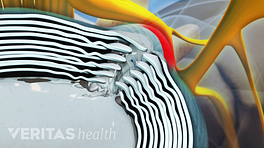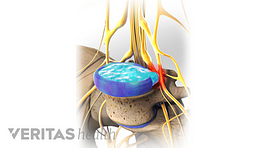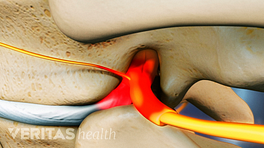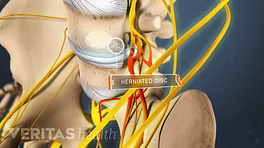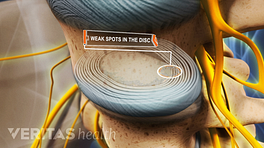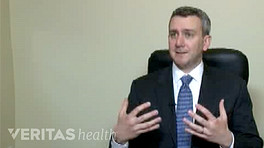A herniated disc in the lumbar spine can irritate or compress a nerve root, causing pain to radiate into the buttocks and legs. Specific exercises to help alleviate sciatica symptoms from a lumbar herniated disc are performed according to which positions cause the patient’s symptoms to centralize—or move from the leg or foot into the low back—making the pain easier to treat.
For many patients, getting the pain to centralize to the low back is accomplished by getting into a backwards bending position, called extension exercises or press-ups.
As the patient’s pain works out of the lower extremity, or the leg, and centralizes into the low back, the exercises typically are advanced to strengthen the low back and abdominal muscles to prevent recurrences of sciatic caused by a herniated disc.
Let’s do the straight leg raise exercise for lower abdominal strengthening. Begin by lying on your back with knees bent up. Perform a posterior pelvic tilt to lock your pelvis in position. Straighten one knee out along the floor. Gently raise the straight leg 6 to 8 inches at a time and return to the starting position. Repeat with the other leg.
Let’s do the prone extension exercise. Begin by lying in the prone position, face down. Place your hands behind your back. Raise your head and chest slightly while still looking at the floor. Begin by holding position for 5 seconds, then gradually work up to 20 seconds. Aim to complete 8 to 10 repetitions.
Now we’ll do the prone combination exercise for back strengthening. Begin by lying face down in the prone position with your head and chest lowered to the floor. With a locked knee, lightly raise an arm and opposite leg 2 to 3 inches from the floor. Begin by holding position for 5 seconds. Complete 8 to 10 repetitions. As strength builds, aim to hold position for 20 seconds.
Let’s do the press-up exercise now. Begin by lying in the prone position with your face down. Prop your body up on your elbows. Keep your hips on the floor. Hold the press-up position initially for 5 seconds. Gradually work up to 30 seconds per repetition. The goal is to complete 10 repetitions. Start slowly and carefully since some patients cannot tolerate this position at first.
To modify this stretch, begin by lying in the prone position with your hands at chest level. Press up on the hands while the pelvis remains in contact with the floor. Keep the lower back and buttocks relaxed for a gentle stretch. This position is typically held for 1 second, repeated 10 times.
Let’s perform abdominal curl-ups. Begin by lying on your back with your knees bent up. Fold your arms across your chest and perform a posterior pelvic tilt. Curl up, lifting your head and shoulders from the floor straight towards the ceiling. Hold for 2 to 4 seconds, then slowly lower to the starting position. Do not attempt to lift the head up too high. As strength builds, aim to complete 2 sets of 10 curls.
For patients with neck pain, place your hands behind the head to support the neck. Be careful not to lift your head with your hands.
This video accompanies the article: Exercise for Sciatica from a Herniated Disc.


